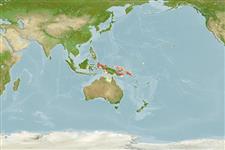>
Gobiiformes (Gobies) >
Gobiidae (Gobies) > Gobiinae
Etymology: Tryssogobius: Greek, tryo, tryso = to wear away + see under Gobius; flavolineatus: Name from Latin 'flavus' for yellow and 'lineatus' for line, refers to the most conspicuous colour marking, the yellow line passing from behind the eye to below the first dorsal fin..
More on author: Randall.
Environment: milieu / climate zone / depth range / distribution range
Ecologia
marino demersale; distribuzione batimetrica 28 - 82 m (Ref. 75950). Tropical
Distribuzione
Stati | Aree FAO | Ecosystems | Presenze | Point map | Introduzioni | Faunafri
Western Pacific: New Guinea and Indonesia.
Size / Peso / Age
Maturity: Lm ? range ? - ? cm
Max length : 2.5 cm SL (female)
Short description
Morfologia | Morfometria
Spine dorsali (totale): 7; Raggi dorsali molli (totale): 10; Spine anali 1; Raggi anali molli: 11; Vertebre: 26. This species is distinguished by the following characters: D VI + I, 10; A I, 11; pectoral rays 17-19; cheek with 2 rows of scales; eye diameter 2.45-2.7 in HL; interorbital width 4.6-5.65 in HL; first dorsal spine longest in adults, 3.65-4.65 in SL, but second and third spines are nearly as long; rhomboid caudal fin, 2.6-3.5 in SL; pectoral fins 3.4-3.6 in SL; grey with a dark-edged yellow line from behind eye, parallel to dorsal profile of postorbital head and nape, and ending below first dorsal fin; base of dorsal fins with a narrow yellow band; caudal fin with 3 blue-edged yellow stripes; pelvic fins whitish (Ref. 75950).
Inhabits sheltered reefs with silty sand and rubble bottoms in 25-82 m (Ref. 90102).
Life cycle and mating behavior
Maturità | Riproduzione | Deposizione | Uova | Fecundity | Larve
Randall, J.E., 2006. Three new species of the gobiid fish genus Tryssogobius from the western and South Pacific. Aqua, 11(3):105-116. (Ref. 75950)
IUCN Red List Status (Ref. 130435)
Threat to humans
Harmless
Human uses
Informazioni ulteriori
Nomi ComuniSinonimiMetabolismoPredatoriEcotossicologiaRiproduzioneMaturitàDeposizioneSpawning aggregationFecundityUovaEgg development
Age/SizeAccrescimentoLength-weightLength-lengthLength-frequenciesMorfometriaMorfologiaLarveDinamica popolazioni larvaliReclutamentoAbbondanzaBRUVS
BibliografiaAcquacolturaProfilo di acquacolturaVarietàGeneticaElectrophoresesEreditarietàMalattieElaborazioneNutrientsMass conversion
CollaboratoriImmaginiStamps, Coins Misc.SuoniCiguateraVelocitàModalità di nuotoArea branchialeOtolithsCervelliVista
Strumenti
Special reports
Download XML
Fonti Internet
Estimates based on models
Preferred temperature (Ref.
123201): 27 - 28.8, mean 27.7 °C (based on 24 cells).
Phylogenetic diversity index (Ref.
82804): PD
50 = 0.5078 [Uniqueness, from 0.5 = low to 2.0 = high].
Bayesian length-weight: a=0.01023 (0.00477 - 0.02194), b=3.02 (2.84 - 3.20), in cm total length, based on LWR estimates for this (Sub)family-body shape (Ref.
93245).
Trophic level (Ref.
69278): 3.1 ±0.3 se; based on size and trophs of closest relatives
Resilienza (Ref.
120179): Alto, tempo minimo di raddoppiamento della popolazione meno di 15 mesi (Preliminary K or Fecundity.).
Fishing Vulnerability (Ref.
59153): Low vulnerability (10 of 100).
